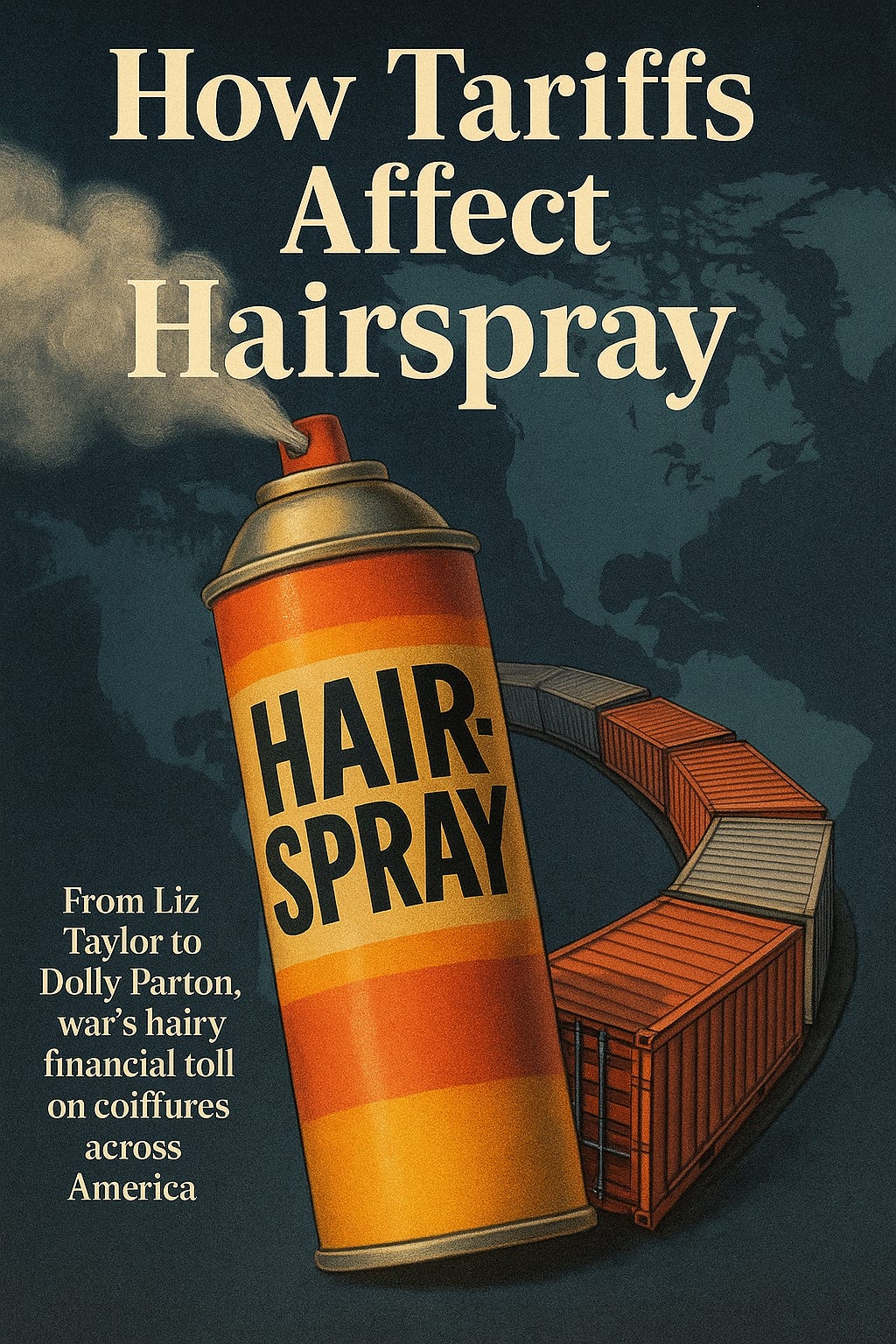The $pray Trade: How Pantene Hairspray Got Caught in a Geopolitical Split-End
Prologue: Of Tariffs and Tresses
There was a time, not long ago, when a can of hairspray stood as a beacon of self-control. It was the final flourish of a morning ritual, a puff of order in a world of chaos. Pantene hairspray, with its modest silhouette and glossy promise of "extra hold," wasn’t just styling product—it was faith in stability, vanity in aerosol form.
Then came tariffs, like moths to a blow-dried flame. Suddenly, a product that once defied humidity was now trapped in a fog of international chess moves and trade posturing. Behind that familiar nozzle, the real story wasn't just about hair—it was about geopolitics, inflation, and the invisible war being waged on your bathroom shelf.
Chapter One: The Cost of a Curl
Pantene may be marketed with Midwest charm, but its DNA is global. The metal can is likely forged in China. The valves, those precise little mechanisms that hiss style into the air? China again. Propellants are refined offshore. And the scent—the ghost of salon confidence—often traces back to chemical compounds processed overseas.
Then came the tariffs. U.S. duties on Chinese imports soared, sometimes reaching 145%. That sweet-smelling can now carried a scent of conflict. What was once a $2 component quietly ballooned to $3.50. Multiply that across P&G’s global footprint, and you don’t just have a price hike—you have a trade war wrapped in a conditioner commercial.
Chapter Two: The Arithmetic of Vanity
Procter & Gamble, like any giant worth its Nasdaq ticker, didn’t absorb the shock. They did what corporations do: they buried the cost in euphemism. "Input cost pressures." "Foreign sourcing volatility." Translation? "You’re paying more, and we hope you don’t notice."
Incremental price hikes—1%, then 2%, now creeping toward 3%—slipped in through shelf tags and masked promotions. Customers barely blinked, unaware they were now co-financing a geopolitical standoff every time they freshened up their bangs.
Chapter Three: Spray and Pray—The Tariff Timeline
In 2018, tariffs hit aluminum, propellants, and fragrance bases like a can dropped from a high shelf. Manufacturers scrambled. Should they move production stateside? That was expensive. Reformulate? Risky. Outsource elsewhere? Logistically maddening.
P&G’s answer was to ride the storm. It leaned into optimization—trimming jobs, consolidating R&D, and automating supply chains. One Midwest plant closed. Another retooled for "higher-value products," a phrase that usually precedes a round of layoffs. Pantene stayed on shelves—but at a price.
Chapter Four: The Scent of Consequence
Not all changes come with a press release. Subtle shifts in fragrance profile, aerosol texture, or nozzle performance hinted at quiet reformulation. Loyal users noticed. Stylists whispered. Some shrugged and moved to cheaper alternatives. But others—those for whom Pantene was a staple, not a choice—felt something was lost.
Because it wasn’t just hairspray anymore. It was a talisman of consistency in an erratic world. And now it smelled... different.
Chapter Five: Of Jobs and Judgment
P&G, facing a $1.5 billion annual tariff burden, began trimming the fat. Unfortunately, that meant 7,000 jobs—real people with mortgages, routines, and kids who didn’t ask to become footnotes in an economic policy debate.
One less worker at the aerosol plant meant fewer customers at the diner. Fewer oil changes at the mechanic. Less foot traffic downtown. All this—because a foreign-sourced valve suddenly required a second look at customs.
Chapter Six: Hair-Splitting Geopolitics
Tariffs sell well in soundbites. They sound strong. Decisive. But they behave more like boomerangs, clipping domestic industries before they even hit their intended target. They masquerade as punishment but punish the consumer. And they turn every mundane product into a case study in unintended consequences.
Pantene hairspray, for all its corporate anonymity, has become a canary in the supply chain coal mine. Every price hike, every clogged nozzle, every reformulated scent is a whisper of global tension reaching your bathroom shelf.
Chapter Seven: The Split End Game
You can’t decouple globalization with rhetoric. The world is stitched together with freight, contracts, polymers, and barcodes. Hairspray, as it turns out, is an artifact of this web—a thing made not in one place but in many, assembled from invisible hands in distant economies.
Pantene’s extra hold now comes with extra baggage: economic, political, even psychological. And the attempt to disentangle it has only proven one thing—some knots can’t be brushed out without breaking strands.
Interlude: The Legends Who Sprayed Before Us
Before tariffs complicated the narrative, hairspray was cultural cement. Dolly Parton’s bouffant, Joan Rivers’ armor-plated wit, RuPaul’s fabulous crown, and James Brown’s high-and-tight all depended on it. Cher? Immortal via lacquer. Elvis? The King of volume. Even fictional legends like Peggy Bundy wouldn’t dare face the day without an aerosol entourage.
They didn’t just use hairspray—they wielded it like a symbol. Identity, defiance, satire, and spectacle—all compressed into a can.
Epilogue: The Comb-Over
In the fluorescent light of a bathroom mirror, a can of Pantene might look like the least political object imaginable. But these days, even your hairspray has foreign policy implications.
So the next time you reach for that can, listen closely. That soft hiss? That’s the sound of trade routes, tariff tables, and diplomatic friction. It’s also the sound of trying to maintain hold in a world coming subtly, spray by spray, undone.
#TariffTangles #PantenePolitics #BeautyVsBrinkmanship #SupplyChainSaga #SprayAndPrey #EconomicsOfHair #AerosolAnxieties #TradeWarTangles #GlobalizationOnTheShelf #TheSplitEndGame #HairsprayIcons #DollyAndJoanApproved


